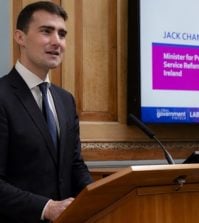The economic emergency services: finance departments and the pandemic

When Covid-19 hit, many finance departments put their economies on life support. Gathering in Estonia, civil service finance leaders considered how their patients responded – and shared their fears about the next course of treatment. Matt Ross reports
When COVID-19 lockdowns froze vast swathes of economic activity, governments sank billions into business support schemes – distributing furlough payments, grants and loans to prevent redundancies and insolvencies. Gathering at the Government Finance Summit (GFS) in Estonia in June, senior leaders from treasuries and finance departments around the world discussed how effectively those programmes protected people’s livelihoods – and considered the financial and political scars left by the pandemic.
While the Summit is held in private, some participants have allowed us to publish their comments; here we present a handful of the key points raised during the discussion.
Well equipped – this time
In some ways, Estonia was well prepared to face COVID-19: in March 2020 public debt was below 10% of GDP – the lowest in the EU – and the famously digitally-savvy country quickly moved working life and public services online. “The infrastructure for switching to a virtual life, in many respects, was well prepared,” commented Märten Ross, an advisor on international relations at Estonia’s Ministry of Finance.

Meanwhile, the government borrowed a further 10% of GDP and distributed grants to health providers, local authorities, and businesses that could show a 30% fall in turnover. These grants were well targeted, said Ross, though it was less obvious in the government’s emergency loan schemes whether funds were addressing “COVID-related crisis shock, or preserving companies that should not have support”: some would have been fine without a loan, he explained, while others were too far gone to be rescued by one.
Estonia’s low debt level made it easy to fund pandemic support packages – but with public debt now at about 20%, it will have less ammunition to combat future challenges. “If there is a similar crisis in five years’ time, I’m not sure that we could stimulate that easily,” commented Ross. “We simply don’t have such big buffers any more.”
Make difficult decisions in easier times
“What really strikes me about the policy response to the pandemic, especially on the fiscal side, was the speed at which finance ministries were able to respond,” commented John McCarthy, the chief economist of Ireland’s Department of Finance. “Lots of countries designed schemes from scratch, and that’s a real positive.”
“But maybe a better approach is to do more scenario planning for the future,” he continued: rather than aiming to move quickly from a standing start, civil service leaders should develop contingency plans that can be pulled off the shelf when required. Noureddine Bensouda, general treasurer of the Kingdom of Morocco, was in full agreement: for both companies and governments, he said, it’s “most important to take decisions when there is prosperity, not in the crisis context.”

Reactions to a crisis rarely provide long-term solutions, he added. And Raúl Enrique Rigo, the secretary of Argentina’s National General Treasury, illustrated his point: Argentina’s tax system needs reform to address evasion and avoidance, he said, and to make it more progressive. Such changes would strengthen the nation’s public finances and its people’s financial resilience, leaving it better placed to face future shocks – and cannot be pushed through during a crisis. “We have to go through those revisions in prosperous times,” he concluded.
The state’s ever-growing role
The pandemic, commented Märten Ross, has “shifted the political and maybe even the economic discussion in society towards a more interventionist approach.” By late 2021, Estonia’s growth rate had exceeded not just pre-crisis levels, but also the long-term trend: “By that time, any public demands for support schemes should have gone away – but they haven’t,” he added. “The expectation of government intervention and support is strong now, even in normal times.”

In many countries, responded Raúl Enrique Rigo, the pandemic and governments’ responses have prompted people to “think again about how we allocate public resources: who is going to pay for what, and to what extent?” These debates, he added, will be at “the centre of the social and political discussion in the years to come.” In the view of John McCarthy, the risk is that people will choose the deceptively easy answer: the “political economy scars of the pandemic”, he commented, include “demand for a bigger state financed by borrowing – because nobody wants to pay more taxes.”
Pandemic responses: imperfect, but effective
Responding rapidly to the sudden arrival of COVID-19, said John McCarthy, finance departments around the world were able to put their economies on life support. “Certainly, there were design flaws in many parts of our scheme, but that was a function of the speed at which policies were developed,” he commented. “The emphasis at the time was getting the money out; keeping the firms alive. The quote from the likes of the IMF was: ‘Spend big, but keep the receipts’.”

Speaking in June – before the energy crisis became acute – he argued that these hastily-designed programmes proved very effective in preventing mass insolvencies, redundancies and bankruptcies. “GDP is back to pre-crisis levels in many countries,” he said. “I think you can say that in most countries, the policies worked. Could they have been better designed if we’d had time? Absolutely. Could we have saved money? Yes. But certainly, in aggregate terms, the approach appears to have worked.”
This is our second report on the 2022 Government Finance Summit, held in Tallinn, Estonia during June. While the Summit is held in private, some participants have allowed us to publish their comments.
The first report covered an analysis of today’s inflationary pressures by John McCarthy, chief economist of Ireland’s Department of Finance; the third explored how finance leaders are supporting – and impeding – digital transformation; and the fourth considered finance leaders’ evolving roles in policymaking. The final report looks at the role finance ministries can support environmental sustainability.

















